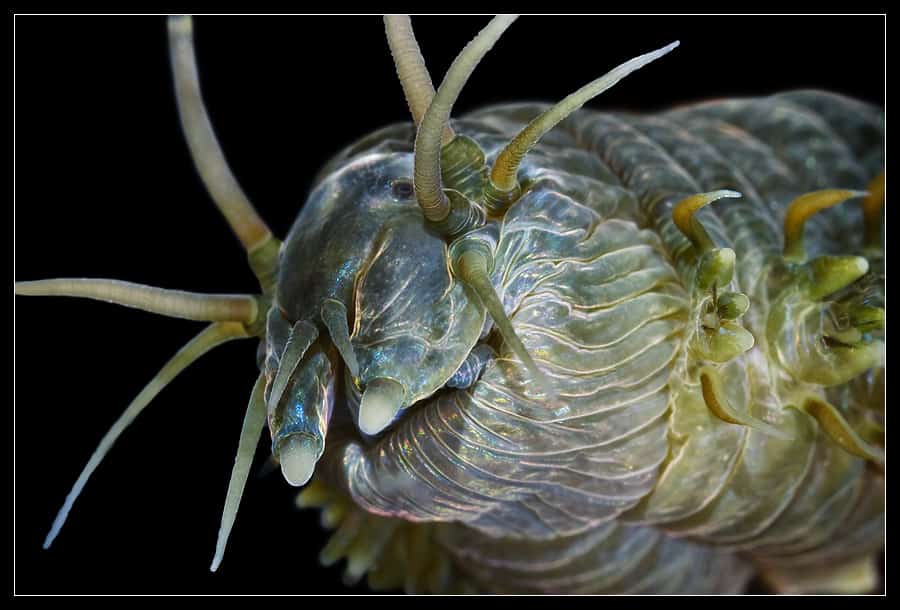Legs also function as gills
Advertisement
Sandworm Scientific Classification
- Kingdom
- Animalia
- Phylum
- Annelida
- Order
- Phyllodocida
- Family
- Nereididae
- Genus
- Alitta
- Scientific Name
- Alitta virens
Read our Complete Guide to Classification of Animals.
Sandworm Conservation Status
Sandworm Facts
- Prey
- Fish, crustaceans, mollusks
- Name Of Young
- Larvae
- Group Behavior
- Solitary
- Fun Fact
- Legs also function as gills
- Biggest Threat
- Overharvesting
- Most Distinctive Feature
- Thick pincers
- Distinctive Feature
- Colorful
- Other Name(s)
- King ragworm
- Habitat
- Beaches and mudflats
- Predators
- Fish and birds
- Diet
- Omnivore
- Lifestyle
- Nocturnal
- Number Of Species
- 1
- Location
- Atlantic coasts
- Nesting Location
- U-shaped burrows
Sandworm Physical Characteristics
- Color
- Yellow
- Red
- Blue
- Orange
- Skin Type
- Smooth
- Lifespan
- Up to 3 years
- Length
- Up to 4 feet
- Age of Sexual Maturity
- 1-3 years
- Venomous
- No
- Aggression
- Low
View all of the Sandworm images!
Also known as “king ragworms,” sandworms (Alitta virens) are marine annelid worms in the family Nereididae. While most measure around 1 foot long, they can measure nearly 4 feet at maximum size. Sandworms possess large pincer-like teeth that they use to catch and feed on invertebrates, crustaceans, and mollusks. Anglers often use sandworms as live bait when sea-fishing, and a sizable “sandworming” industry exists in coastal areas of New England and along the Atlantic coasts of Europe.
5 Sandworm Facts
- A sandworm’s parapodia (external protrusions) function both as legs and as their primary means of respiration.
- Sandworms reproduce via a process known as “swarming,” wherein females release a chemical that entices males to release their sperm into the water, where the females eject their eggs.
- Anglers often use sandworms to fish for striped bass, fluke, whiting, and other fish.
- Sandworms can detect the chemical presence of certain predators as well as other sandworms.
- When threatened, sandworms may bite humans with their powerful, hooklike jaws, but bites occur very rarely.
Sandworm Scientific Name
The sandworm belongs to the annelid worm phylum Annelida. This phylum contains over 22,000 species, including earthworms, leeches, and ragworms. It is a member of the Polychaeta class of marine worms commonly known as polychaetes or bristle worms. The word Polychaeta derives from the Geek word polychaites, meaning “having abundant hair,” from poly (many) and chaites (hair). This name refers to the fact that polychaete worms feature numerous small hairlike bristles along their bodies.
Sandworms belong to the ragworm or clam worm family Nereididae. They are members of the genus Alitta, which includes two other species – the pile or clam worm (Alitta succinea) and Allita grandis. The word Allita likely stems from the Old High German word Adalhaidis, meaning “noble” or “elite.” Meanwhile, its specific name, virens, derives from the Latin word for “green” or “flourishing.” Due to its large size and bright colors, the sandworm frequently goes by “king ragworm,” particularly in Europe.
The term “sandworm” can sometimes refer to other species of marine worms. For example, in the UK, the lugworm (Arenicola marina), often goes by the name sandworm.
Sandworm Appearance
On average, most sandworms measure around 1 to 2 feet long. However, large specimens can grow to nearly 4 feet long. They feature characteristic blue heads equipped with two thick black pincers. Sandworms vary in color, appearing bright blue, yellow, red, and orange. They can move their head and pincers in and out like a piston and sport dozens of little protrusions along the body known as parapodium. These protrusions function as gills and as legs that the sandworm uses for locomotion. Each parapodium ends in small, fine hairs known as setae.

Sandworms feature characteristic blue heads equipped with two thick black pincers.
©Alexander Semenov, CC BY 2.0 <https://creativecommons.org/licenses/by/2.0>, via Wikimedia Commons – License
Sandworm Behavior
By and large, sandworms live most of their lives in their U-shaped burrows. They utilize ambush tactics to hunt prey and are primarily nocturnal. That said, they will occasionally vacate their burrows for two reasons. Firstly, sandworms may leave their tunnels to scavenge for detritus, algae, or other food. Second, males will leave their tunnels during the spawning season in order to release their sperm.
While sandworms will occasionally bite humans, they rarely, if ever, do so. Occasionally, their bites can cause secondary infections, so always make sure to treat a sandworm bite.
Sandworm Habita
You can find sandworms along coastal beaches throughout the Northern Hemisphere. They prefer temperate zones but can also live in tropical and subtropical waters. The densest concentrations of sandworms live along the Atlantic coasts of Canada, the United States, the UK, and other parts of western Europe. However, you can also find sandworms along the coasts of the Mediterranean, as well as the Arctic and Indian Oceans.
Sandworms construct U-shaped burrows along sandy beaches and intertidal mudflats. They use their heads in a piston-like motion to construct their burrows, which typically lie a few inches below the surface.
Sandworm Diet
Sandworms are omnivores that will eat pretty much anything that they can find. They feed on aquatic organisms, including small crustaceans, mollusks, and other worms. Additionally, sandworms will also feed on algae and plankton, and scavenge the sea floor for detritus. When unable to find adequate food, sandworms may ingest mud and sand and then filter out the micronutrients trapped in the substrate.
Sandworms hide in their tunnels and dart their heads out when prey wanders within striking distance. They use their thick, hook-like teeth to grab their prey, which they then drag back inside their tunnels.
Sandworm Predators and Threats
Numerous larger animals prey on sandworms. Common sandworm predators include fish such as whiting, bluefish, flatfish, and striped bass. Sea birds, such as gulls, will feed on sandworms they find on beaches.
That said, the greatest threat to sandworms comes not from predators but from humans. Every year, sandworm hunters harvest millions of pounds of sandworms for use in the commercial live-bait industry. These fisheries pack the sandworms in seaweed and ship them around the world for use as live bait.
Sandworm Reproduction and Life Cycle
Sandworms reproduce via a process known as “swarming.” Upon reaching sexual maturity at around 1 or 3 years old, sandworm females initiate reproduction by releasing pheromones into the water. This chemical entices male sandworms to release their sperm. Males exit their burrows at high tide and swim using an eel-like motion through the water, releasing sperm as they go. Shortly after releasing their sperm, the males die. Meanwhile, females remain in their burrows and eject their eggs into the water, which get fertilized by the males’ sperm. Shortly after ejecting their eggs, the females also die.
Sandworm eggs either remain inside the burrow, inside jelly masses attached to the burrow or float in the open water. The young sandworms emerge as larvae and later metamorphose into juvenile sandworms and, eventually, mature adults. Sandworms can live nearly 3 years under the right conditions, although most specimens won’t live this long.
Sandworm Population
The IUCN has yet to evaluate the conservation status of sandworms. As a result, the IUCN currently classifies the sandworm as “Not Evaluated.” Sandworms enjoy a widespread distribution throughout much of the Northern Hemisphere. However, sandworm populations in certain regions are on the decline. For example, sandworms along the coast of New England in the United States have diminished greatly during the past few decades. Experts believe this reduction stems from overharvesting mature sandworms before they can spawn and produce offspring. For decades, Maine has ranked as the largest harvester of sandworms in the United States. However, over the past few decades, the state’s annual sandworm harvest has plummeted by nearly two-thirds.
View all 293 animals that start with SSandworm FAQs (Frequently Asked Questions)
Are sandworms omnivores, herbivores, or carnivores?
Sandworms are omnivores that feed on smaller worms, crustaceans, and mollusks, as well as algae. They may also scavenge for detritus or filter out microscopic plankton from mud and sand.
How do sandworms avoid predators?
Sandworms are one of the only known annelid worms that rely on chemical signals to detect predators. They can sense the chemical presence of predators, such as flatfish, as well as other sandworms. Oftentimes, they show great distress when detecting the chemicals of other sandworms, as this may indicate that a sandworm nearby was recently eaten.
Can you use sandworms as bait?
Sandworms are among the most popular live bait used by anglers for sea fishing. The state of Maine operates commercial sandworm harvesting fisheries that generate around $8 million in revenue each year as of 2020.
How long do sandworms live?
Under optimal conditions, a sandworm can live for nearly 3 years. That said, most sandworms don’t live this long in the wild.
Thank you for reading! Have some feedback for us? Contact the AZ Animals editorial team.
Sources
- , Available here: https://blogs.scientificamerican.com/running-ponies/meet-the-enormous-king-ragworm-and-its-adorable-offsider-the-slender-ragworm/
- , Available here: https://britishseafishing.co.uk/ragworm/
- , Available here: https://www.maine.gov/dmr/fisheries/commercial/fisheries-by-species/worms-marine

















